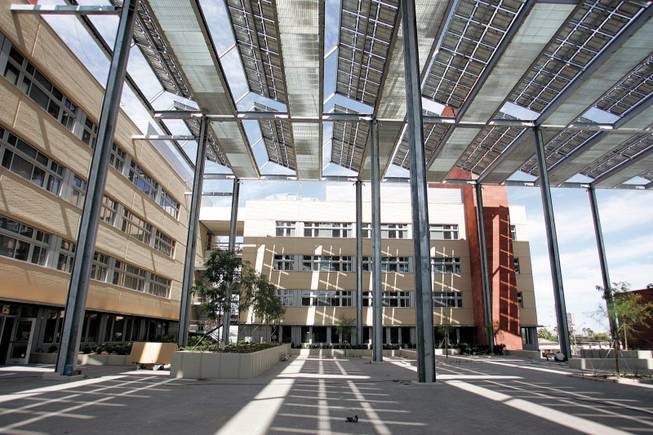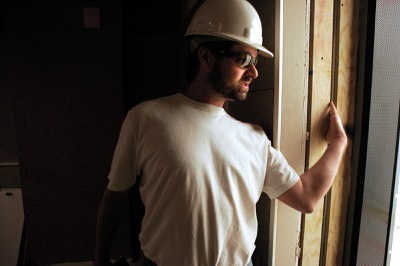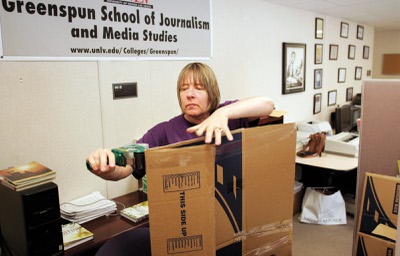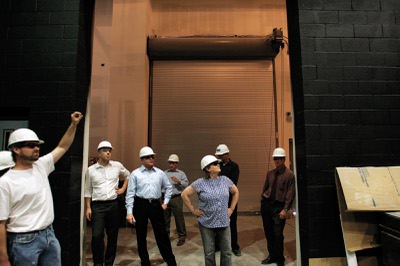
The Greenspun College of Urban Affairs will house six UNLV departments, including communication studies, criminal justice, and journalism and media studies.
Wednesday, June 4, 2008 | 2 a.m.
Greenspun College of Urban Affairs Building
UNLV's Greenspun College of Urban Affairs' new home will be a 120,000-square-foot classroom and office building housing state-of-the-art labs and radio and television broadcasting facilities. Aryth Sohn, director of the Hank Greenspun School of Journalism and Media Studies, says the school has waited a long time time for the building, which will help the school become one of the top journalism programs in the country.
Sun Archives
- Journalism 2.0 (1-9-2008)
- Would UNLV budget cuts turn off donor spigot? (11-30-2007)
- College of Urban Affairs to get new home (1-25-2007)
The Greenspun College of Urban Affairs’ new home at UNLV will, by all accounts, be dazzling.
Besides classrooms and offices, the 120,000-square-foot building will house state-of-the-art labs and radio and TV studios.
But as students, staff and faculty members get ready to occupy the new facility, their excitement might be tempered. Like other divisions at UNLV, urban affairs is downsizing in response to funding cuts.
The Greenspun College is eliminating several full-time visiting professor positions and trimming its budget for part-time instructors, who conduct many undergraduate courses. As a result, students will have fewer classes from which to choose and classes will be larger.
“We’re opening a new building, but it’s really the teachers that are the fundamental aspect of it” (education), said Derek Schoen, who was president of UNLV’s Association of Students in Communication before graduating in May with a degree in journalism and media studies.
“It seems like we were just about to turn the corner, and all of a sudden we are going to be sent back to a mediocre status.”
Seven academic departments make up the urban affairs college: communication studies, criminal justice, environmental studies, journalism and media studies, marriage and family therapy, public administration, and social work. All but marriage and family therapy are to relocate to the new Greenspun Hall, which is scheduled to open in August.
The hits they will take as they move in are examples of how Nevada’s financial crisis is hurting UNLV. The reductions are part of a university effort to tighten spending in the face of state-mandated cuts and falling enrollment.
In the next academic year, hundreds of classes previously taught by instructors on short-term contracts will be cut or taken over by other faculty members, Executive Vice President and Provost Neal Smatresk said.
Though some students might cheer the prospect of tenured and tenure-track professors as teachers in place of part-timers, full-time professors will be spread thin next year as class sizes grow and they will have less time for research, which could hurt UNLV’s efforts to become a top-tier research university.
UNLV is also losing specialists such as Charlotte-Anne Lucas, a visiting professor in the School of Journalism and Media Studies.
She came to UNLV in 2006 with the understanding that her stint would last three years. But she was on a one-year contract and recently found out that her department was eliminating her position to save money.
“I never expected to love this place as much as I do, and I do, and I’m stomping my little feet,” said Lucas, who was content director for a San Antonio newspaper and TV station Web site before coming to UNLV. She took a pay cut in the tens of thousands of dollars to teach. “I would love to stay. (But) it’s not my impression that, barring divine intervention, there’s much that can be done.”
A print journalist turned multimedia guru, Lucas trained students to tell stories on the Web using blogs, online slide shows, audio and video recordings and other materials.
Greenspun Hall will come with high-end equipment for producing online content — Lucas’ forte. Though faculty members will fill in for Lucas, she was the only full-time instructor with real-world experience in disseminating news through the Internet, said Ardyth Sohn, director of the School of Journalism and Media Studies.
“What was great about her is I pulled her right out of the industry,” Sohn said.
“I had to talk hard and heavy to get her to come ... We got her for a salary decrease, and she’s wonderful with the students.”
Sohn’s school is also losing a second full-time faculty member, a visiting professor who taught public relations courses and coordinated student internships.
In the 2007-08 school year, part-time instructors handled more than three dozen journalism and media studies classes, Sohn said. In 2008-09, she expects to have enough money to pay part-timers to teach 16 classes.
She added that budget plans are not yet firm, and that “we might receive even less in part-time funding.”
Many faculty members who taught two classes per semester will teach three. And the maximum enrollment for all urban affairs classes is slated to rise by at least 10 percent, said Lee Bernick, Greenspun College’s newly appointed interim dean.
As they chop and slash, Bernick and other administrators are working to ensure that students continue to have access to core classes. So, though urban affairs might offer fewer electives, “no student should say, ‘I can’t graduate,’ ” Bernick said.
“Our first responsibility as a public university is to provide an education to our students who want an education,” Bernick said. “That’s our first responsibility. Does it hurt? We’re offering fewer courses. The courses are going to be larger. We’re not going to be able to do our research. These cuts are not good things.”
That the completion of Greenspun Hall is coinciding with the state’s financial crisis is perhaps an omen of what’s in store for Nevada’s public colleges in years to come.
The Greenspun family, owners of the Las Vegas Sun, gave $37 million toward the building, and UNLV officials — while decrying budget cuts — have acknowledged their school’s prospects will hinge increasingly on private donors’ generosity.
Having weathered one salvo of reductions, UNLV could soon be subject to another barrage. State officials have asked public agencies, including the university system, to prepare for deep cuts to anticipated funding levels in the next biennium.
Chancellor Jim Rogers, who oversees public higher education across Nevada, issued a six-page memo last week saying such budget slashing could force state colleges to eliminate areas of study or raise student fees dramatically. Some of Rogers’ less dire predictions — that schools would offer fewer and larger classes — are playing out at UNLV.
In the current round of cutbacks, not all departments at the university are suffering equally. Those such as engineering that rely less on part-time instructors are looking at smaller cuts. Others, such as the College of Education, that depend heavily on part-timers are scaling back more.
Even so, UNLV as a whole will emerge from budget cuts as a slimmer and, arguably, lower-quality institution.
As budgets for part-time instructors shrink across the university, tenured and tenure-track professors will have to teach more, leaving them fewer hours for mentoring graduate students, less time to apply for research grants and to prepare work for publication in books or peer-reviewed journals.
That type of environment bodes ill for UNLV’s ambitions.
Recognizing that the best scholars can easily find opportunities elsewhere, Smatresk has asked deans to ensure that top researchers have time for projects.
“It’s my hope that our most active scholars will not have their teaching loads (increased),” he said.
Smatresk acknowledged that UNLV has an unhealthy dependence on part-time instruction, saying students benefit from working with full-time faculty members whose research keeps them apprised of the most recent advances in their fields.
But the way to wean an institution off part-time teaching is to hire more full-time professors, and not to take steps such as increasing class sizes that can hurt students’ ability to learn, Smatresk said.
In the competitive world of higher education, UNLV is a young college struggling to make a name for itself. This past academic year, students, staff and faculty members toasted their school’s 50th anniversary by drafting a list of goals they hope UNLV will meet as it matures.
Many factors drive success, but ultimately, money will have a lot to do with whether that list will be a blueprint for the future — or merely a register of unattainable dreams.




Join the Discussion:
Check this out for a full explanation of our conversion to the LiveFyre commenting system and instructions on how to sign up for an account.
Full comments policy